The trailer for #DCComics #BlueBeetle movie has been released.
Movies
Johnny Depp Leaves “Fantastic Beasts” Franchise
Actor Johnny Depp will no longer be playing the role of Gellert Grindelwald in J.K. Rowlings’ #FantasticBeasts movie franchise, which is a series of prequels to #HarryPotter. Depp made the announcement today on his Instagram account claiming that #WarnerBrothers had asked him to leave the franchise.
Releasing a short statement of their own, Warner Brothers has confirmed that Depp will leave the franchise, but did not comment on the nature of the separation or confirm that they asked him to go.
Coming just days after Depp lost a libel lawsuit against a British tabloid that characterized him as being abusive, it’s likely that this is related to the ongoing controversy surrounding back-and-forth abuse allegations between himself and his ex-wife Amber Heard. Depp did not specifically link the two in his letter, but he did bring the trial up, pledging to appeal the ruling.
His Instagram post can be seen below:

References
John Boyega: Disney Sidelined his “Star Wars” Character
In an interview with British GQ magazine published on Sept. 2, 2020, actor John Boyega candidly criticized how The #Disney Company treated himself and his character of Finn in the #StarWars sequel trilogy. In other words, #racism marred his time spent in a galaxy far, far away. Boyega said,
“You get yourself involved in projects and you’re not necessarily going to like everything. [But] what I would say to Disney is do not bring out a black character, market them to be much more important in the franchise than they are and then have them pushed to the side. It’s not good. I’ll say it straight up.”
In the first sequel trilogy film (“Star Wars: #TheForceAwakens”, directed by J.J. Abrams), Boyega played Finn, a former Stormtrooper who wielded a lightsaber, as a major driving force of the narrative. But in the following two films (“Star Wars VIII: #TheLastJedi” and “Star Wars IX: #TheRiseOfSkywalker”), Disney & #LucasFilm gave more space to Rey (Daisy Ridley) and Kylo Ren (Adam Driver), and sidelined Finn.
But John Boyega wasn’t only referring to himself, he was also talking about the other people of color in the cast. Namely, Naomi Ackie, Kelly Marie Tran and Oscar Isaac: who he feels suffered the same treatment. Boyega acknowledges that some people will say he’s “crazy” or “making it up”, but the reordered character hierarchy of “The Last Jedi” was particularly hard to take. Boyega went on to say the following in the interview:
“Like, you guys knew what to do with Daisy Ridley, you knew what to do with Adam Driver. You knew what to do with these other people, but when it came to Kelly Marie Tran, when it came to John Boyega, you know fuck all. So what do you want me to say? What they want you to say is, ‘I enjoyed being a part of it. It was a great experience…’ Nah, nah, nah. I’ll take that deal when it’s a great experience. They gave all the nuance to Adam Driver, all the nuance to Daisy Ridley. Let’s be honest. Daisy knows this. Adam knows this. Everybody knows. I’m not exposing anything.”
In an August, 2018 essay published in the New York Times, Kelly Marie Tran, who is Vietnamese-American and was introduced in “The Last Jedi” before being sidelined in “The Rise of Skywalker”, wrote about the her own ordeal with racism, saying she had gone “down a spiral of self-hate” due to all the harassment she had received:
“It wasn’t their words, it’s that I started to believe them. Their words seemed to confirm what growing up as a woman and a person of color already taught me: that I belonged in margins and spaces, valid only as a minor character in their lives and stories.”
“[Society] taught me I existed only in the background of their stories, doing their nails, diagnosing their illnesses, supporting their love interests—and perhaps the most damaging—waiting for them to rescue me. And for a long time, I believed them.”
When John Boyega’s face first appeared from beneath a stormtrooper helmet in the first released trailer for “The Force Awakens”, racist hashtags like #BoycottStarWarsVII suddenly appeared on social media. Boyega acknowledged the boycotts in the British GQ magazine directly, saying that he was
“the only cast member who had their own unique experience of that franchise based on their race.… It makes you angry with a process like that. It makes you much more militant; it changes you. Because you realize, I got given this opportunity, but I’m in an industry that wasn’t even ready for me. Nobody else in the cast had people saying they were going to boycott the movie because [they were in it]. Nobody else had the uproar and death threats sent to their Instagram DMs and social media, saying, ‘Black this and Black that and you shouldn’t be a stormtrooper.’ Nobody else had that experience. But yet people are surprised that I’m this way. That’s my frustration.”
Then there was Disney’s official poster for “The Force Awakens” released in China. While it was very similar to the one released in the U.S., Boyega’s image as Finn, which was prominent in the U.S. poster, was severely shrunk in the Chinese one.
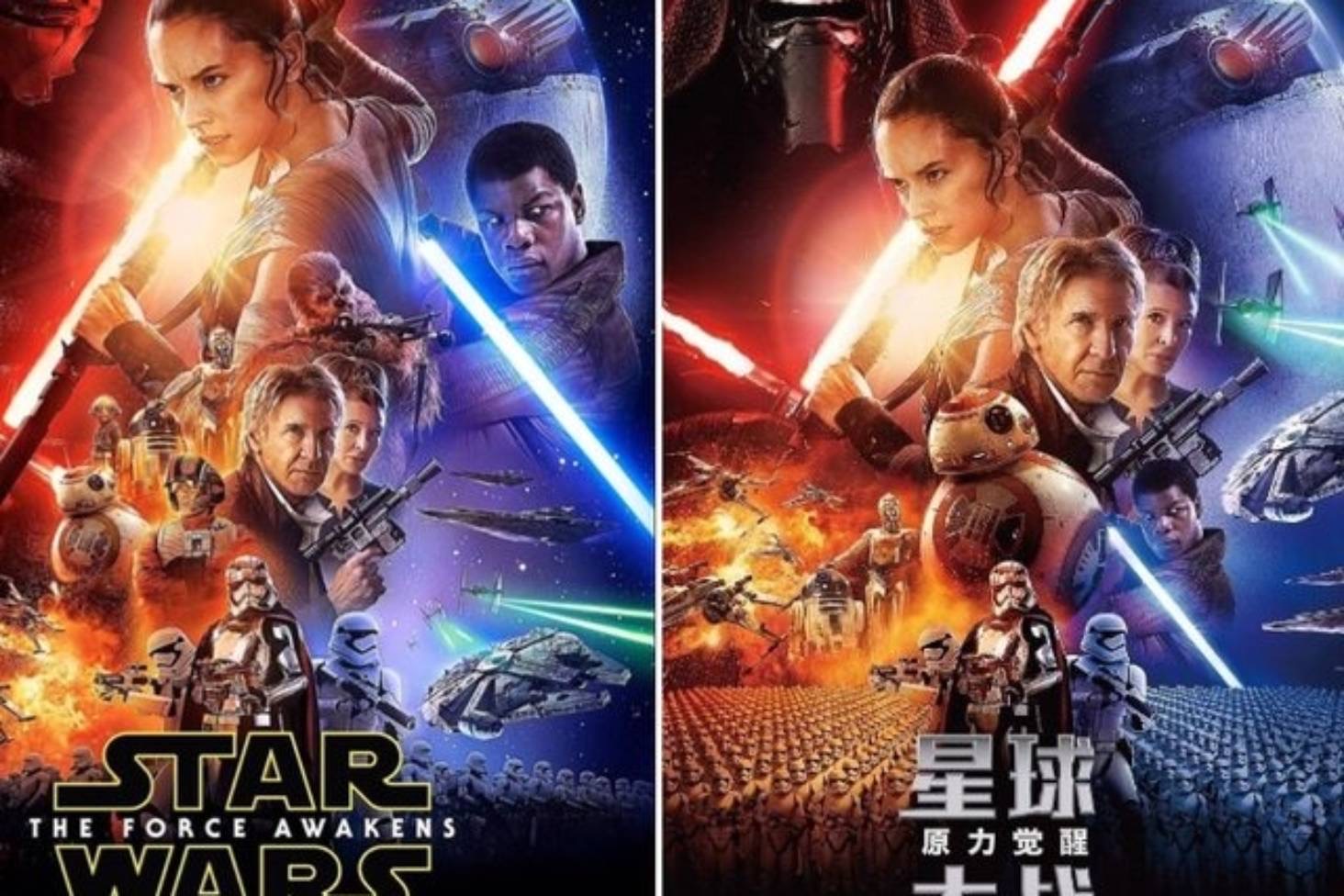
“Star Wars VII: The Force Awakens” Posters released in the U.S. (Left) and China (Right).
John Boyega’s words in the interview are an indictment on the systemic mistreatment of black characters in blockbuster films, saying,
“They’re always scared. They’re always fricking sweating.”
Boyega also viewed the return of director J.J. Abrams to “The Rise of Skywalker” as a salvage job, saying,
“Everybody needs to leave my boy alone. He wasn’t even supposed to come back and try to save your shit.”
While Boyega acknowledged that “Star Wars” was an “amazing opportunity” and a “stepping stone” that has precipitated so much good in his life and career, he was palpably exhilarated to be finally saying all this. To dismiss his words as merely professional bitterness or paranoia is to miss the point. His primary motivation is to show the frustrations and difficulties of trying to operate within what can feel like a permanently rigged system. He is trying to let you know what it feels like to have a boyhood dream ruptured by the toxic realities of the world.
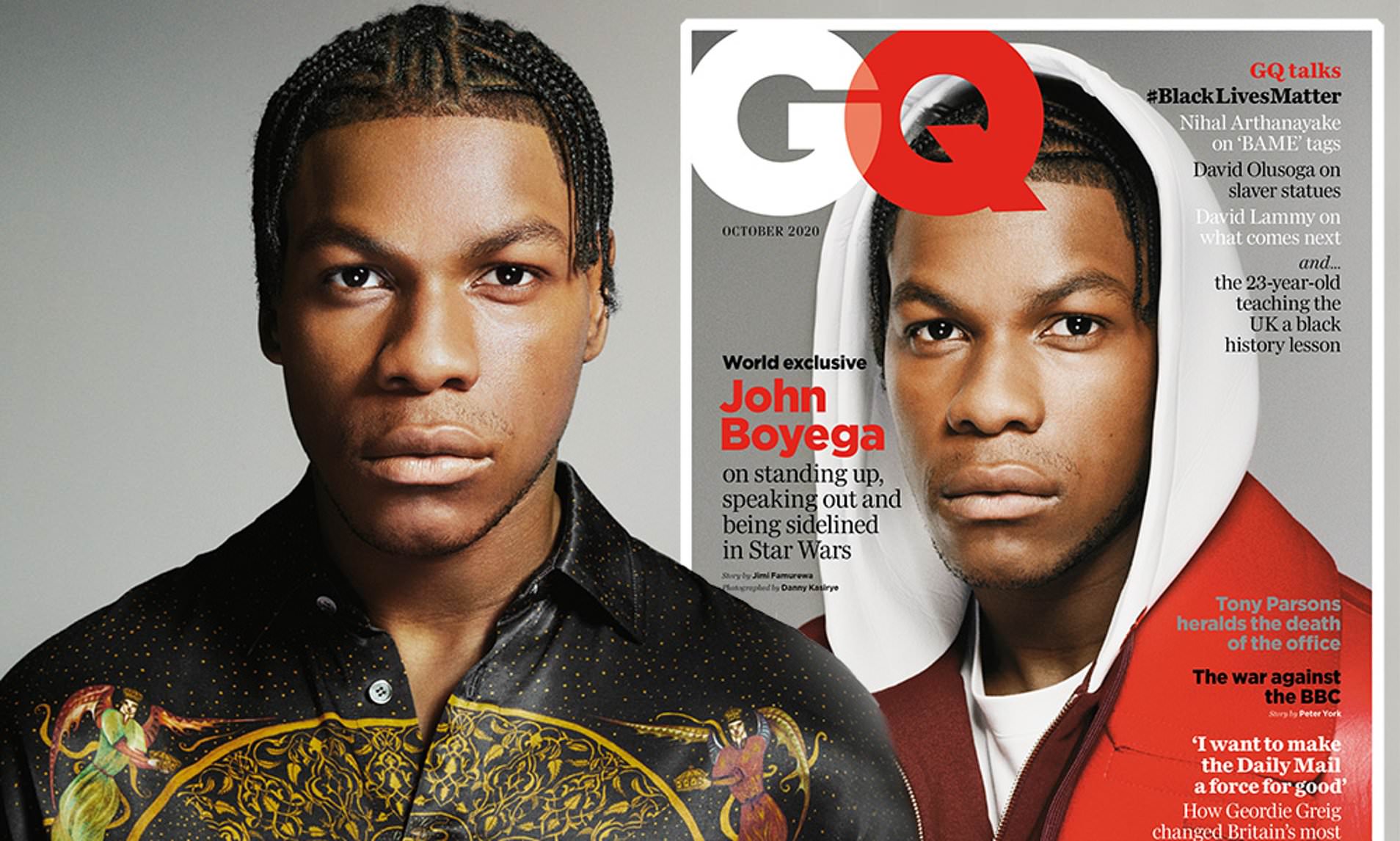
John Boyega
References
- People Magazine: John Boyega Says His Star Wars Character Was ‘Pushed to the Side’ by Disney: ‘It’s Not Good’
- British GQ Magazine: John Boyega: ‘I’m the only cast member whose experience of Star Wars was based on their race’
- Vanity Fair Magazine: John Boyega Gets Real About Star Wars and Racism: “It Changes You”
- Vanity Fair Magazine: Kelly Marie Tran Opens Up About Racist Harassment: “I Went Down a Spiral of Self-Hate”
- CNN: Chinese state media hits back at claims of racist ‘Star Wars’ poster
Examining User Rating Demographics on IMDb for All “Star Wars” Films
Now that there are more than 100,000 user ratings for “#StarWars IX: #TheRiseOfSkywalker” on IMDb, we can do a comparison the user rating demographics for all of the live-action “Star Wars” films to see if any patterns emerge. The demographics are illustrated in the chart below.
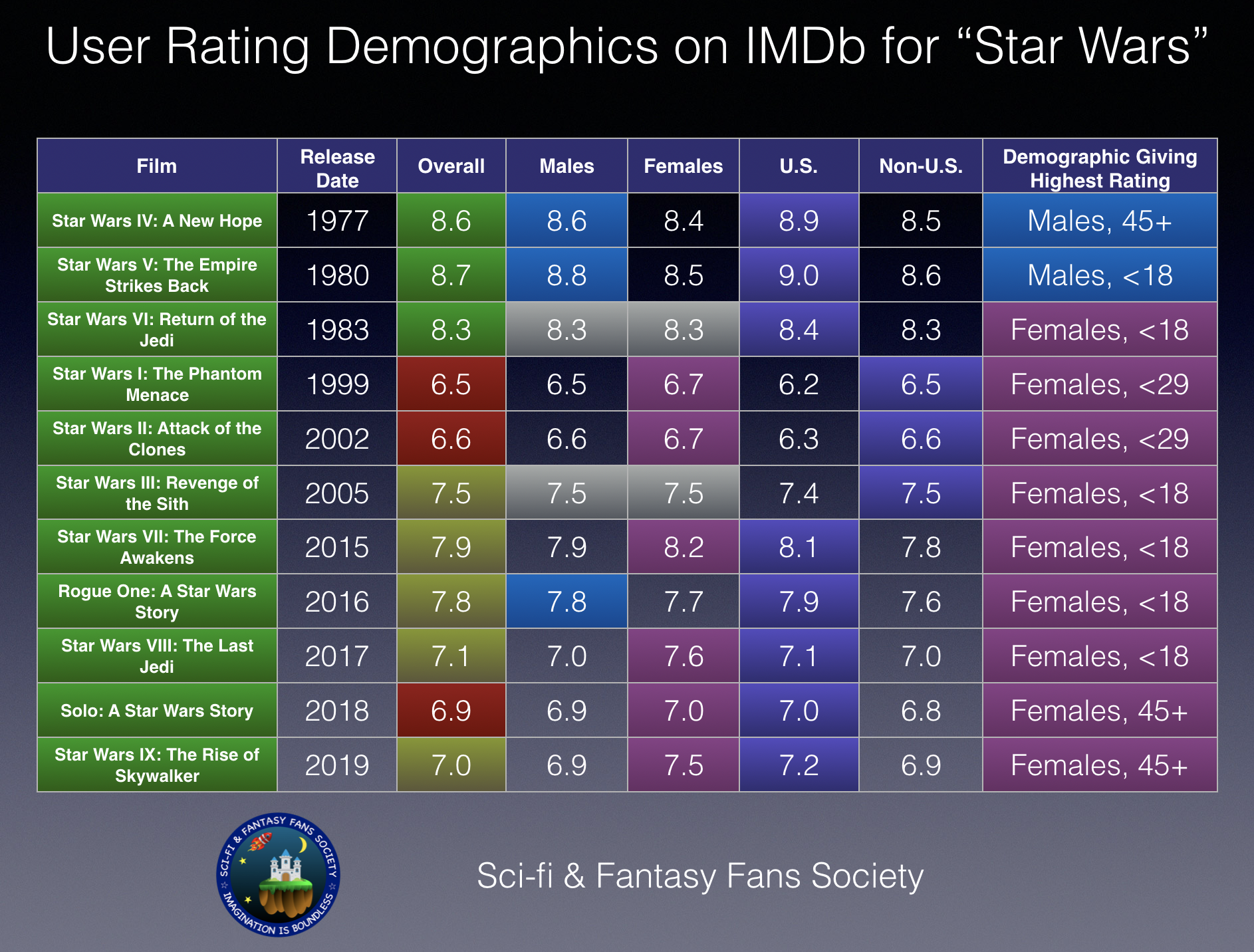
User Rating Demographics on IMDb for Live-Action “Star Wars” Films
Color Codings
- Overall ratings are color-coded based on the overall score as follows:
- Green: a score of at least 8.0.
- Yellow: a score between 7.0 and 7.9.
- Red: a score that is 6.9 or lower.
- For overall male and female user ratings:
- Scores marked in blue mean that the overall male score was higher than the overall female score.
- Scores marked in pink mean that the overall female score was higher than the overall male score.
- Scores makes in grey mean that the male and female scores are the same.
- For U.S. versus non-U.S. user ratings:
- Scores marked indigo in either column are the higher of the two scores for each fim.
- For “Demographic Giving Highest Ratings:
- Blue means that a male demographic gave the highest rating.
- Pink means that a female demographic gave the highest rating.
Results
The results are quite interesting, as listed below:
- Overall User Ratings:
- The highest rated film overall from all demographics is “Star Wars V: The Empire Strikes Back” with an overall user rating of 8.7.
- The lowest rated film overall from all demographics is “Star Wars I: The Phantom Menace” with an overall user rating of 6.5.
- The group of films with the highest overall ratings overall is the original trilogy (OT); Episodes IV, V & VI. The average of the 3 overall ratings is 8.53.
- The group of films with the overall lowest ratings is the prequel trilogy (PT); Episodes I, II & III. The average of the 3 overall ratings is 6.87.
- Disney’s sequel trilogy (Episodes VII, VIII & IX) have an overall average user rating of 7.33.
- U.S. versus Non-U.S. User Ratings
- U.S. and Non-U.S. voters disagree on every single “Star Wars” film.
- The film with the overall highest rating from U.S. voters, as well as Non-U.S. voters, is “Star Wars V: The Empire Strikes Back” with a U.S. rating of 9.0 and a Non-U.S. voter rating of 8.6.
- Of the 11 live-action “Star Wars” films, 8 are rated higher by U.S. voters overall than by Non-U.S. voters: the original trilogy (Episodes IV, V & VI), the Disney sequel trilogy (Episodes VII, VIII & IX) and the 2 standalone films (“Rogue One” & “Solo”).
- The 3 films that Non-U.S. voters gave higher overall ratings than U.S. voters are the three prequels (PT): Episodes I, II and III.
- Male versus Female User Ratings:
- Three films are preferred by male voters more than female voters: two of the original trilogy films (Episodes IV & V) and the standalone film “Rogue One”.
- Six films are preferred by female voters more than by male voters: two of the prequel films (Episodes I & II), the Disney sequel trilogy (Episodes VII, VIII & IX) and the standalone film “Solo”.
- There was agreement between both male and female voters on two films: Episode IV (from the original trilogy) and Episode III (from the prequel trilogy).
- The two films with the widest margin between male and female ratings are two of the Disney sequel trilogy films: Episodes VIII and IX, which both have discrepancies of 0.6.
- There is very little overall discrepancy between male and female voters for the six films produced and written by George Lucas (the original trilogy and the prequels): their average difference in overall user ratings is only 0.03, which is only slightly in favor of males.
- There is a higher overall average discrepancy between male and female voters for the five films produced by Disney (Disney’s sequel trilogy and the 2 standalone films): the overall overage difference in user ratings is 0.3 in favor of female voters.
- Comparing the overall differences between male & female voters for the films produced by George Lucas and the films produced by Disney, the overall discrepancy between male & female voters for the Disney films is much larger than for the films produced by George Lucas by a factor of 10. This suggests that the films that George Lucas produced had a much broader appeal to both sexes, while the Disney-produced films were intended to appeal more to women.
- Films that are more popular with female voters tended to have lower overall user ratings:
- The average overall user ratings for the 3 films preferred by male voters is 8.3.
- The average overall user ratings for the 6 films preferred by female voters is 7.0.
- Examining the “Demographic Giving Highest Rating” Groups
- Of the 11 live-action films, only 2 of the films (the two oldest films, Episodes IV and V) had a male demographic giving the highest rating.
- Of the 11 live-action films, 5 of the films received their highest rating from the females under 18 years old demographic.
- Of the 9 films that have their highest ratings coming from female voters, 2 of those demographics were from females that are at least 45 years of age or older: “Solo” and Episode IX.
Interpreting the Results
Looking at the breakdown of the demographics for the user ratings for all of the “Star Wars” films, a few interpretations can be drawn, but must be taken within the context of the data that was examined.
- It would appear that Disney has tended to make the films that it has produced more appealing to female viewers than male viewers, while George Lucas appears to have tried to appeal more to both genders.
- Even after 11 live-action films, the original three films remain the most highly rated.
- Overall, the films have tended to be preferred by U.S. viewers more than Non-U.S. viewers.
References
- IMDb Ratings for “Star War IV: A New Hope”
- IMDb Ratings for “Star Wars V: The Empire Strikes Back”
- IMDb Ratings for “Star Wars VI: Return of the Jedi”
- IMDb Ratings for “Star Wars I: The Phantom Menace”
- IMDb Ratings for “Star Wars II: Attack of the Clones”
- IMDb Ratings for “Star Wars III: Revenge of the Sith”
- IMDb Ratings for “Star Wars VII: The Force Awakens”
- IMDb Ratings for “Rogue One: A Star Wars Story”
- IMDb Ratings for “Star Wars VIII: The Last Jedi”
- IMDb Ratings for “Solo: A Star Wars Story”
- IMDb Ratings for “Star Wars IX: The Rise of Skywalker”
And the Next Batman Is… Robert Pattinson
#Variety is reporting that actor Robert Pattinson is in negotiations to play the titular role in Matt Reeves’ forthcoming superhero film #TheBatman, which is slated to hit theaters on June 25, 2021. While sources say it’s not yet a done deal, Pattinson is the top choice and it’s expected to close shortly.
Matt Reeves (the filmmaker behind the last two #PlanetOfTheApes sequels) assumed the directing duties from Ben Affleck for #Batman in January 2017. Ben Affleck and Warner Bros. began discussing the actor-director leaving the Caped Crusader behind following #JusticeLeague and allowing Reeves to pick his own actor to play Bruce Wayne. Reeves will produce “The Batman” with his “Planet of the Apes” collaborator Dylan Clark.
At 32, Pattinson would be the youngest actor to play Bruce Wayne / Batman. He formerly played Cedric Diggory in the fourth #HarryPotter film (“The Goblet of Fire”), as well as the heartthrob character of Edward Cullen in the #Twilight film series.

Robert Pattinson
Warner Brothers is hoping that the latest iteration of the DC icon will be done right following the box office disappointments of #BatmanVsSuperman and “Justice League.”
- “Batman v Superman: Dawn of Justice” earned $330-million domestically and $543-million internationally to garner a total box office of $874-million worldwide from a budget of $250-million.
- “Justice League” faired worse, earning only $229-million domestically and $429-million internationally for a a total box office of $658-million worldwide. The film’s budget was not reported.
References
“Avengers: Endgame” Obliterates Box-Office Records, Earns $1.2-Billion on Opening Weekend
#Disney & #MarvelComics did extremely well for the opening weekend of “#Avengers: #Endgame” with a record-breaking $1.2-billion earned worldwide! Broken down, domestically the movie earned $350-million and internationally $859-million, both of which also shattered previous box-office records!
Endgame’s $350-million domestic opening weekend is nearly $93 million larger than the previous record set by Avengers: Infinity War ($257.69 million) that was set just last year and a whopping 90% of the overall weekend market share.
Here are part of the records that Endgame has broken. Most of the previous records were held primarily either by “Avengers: Infinity War” or “Star Wars VII: The Force Awakens”:
- Largest Thursday Previews: $60 million
Previous Record: $57 million (Star Wars: The Force Awakens) - Largest Friday, Opening Day and Single Day: $156.7 million
Previous Record: $119.1 million (Star Wars: The Force Awakens) - Largest Saturday: $109 million
Previous Record: $82.1 million (Avengers: Infinity War) - Largest Sunday: $84.3 million
Previous Record: $69.2 million (Avengers: Infinity War) - Domestic Opening Weekend: $350 million
Previous Record: $257.69 million (Avengers: Infinity War) - #1 Movie Market Share: 90%
Previous Record: 84.5% (Avengers: Age of Ultron) - Fastest to $100 Million: 1 Day
Previous Record: 1 Day (Star Wars: The Force Awakens) - Fastest to $150 Million: 1 Day
Previous Record: 2 Days (Avengers: Infinity War) - Fastest to $200 Million: 2 Days
Previous Record: 3 Days (Avengers: Infinity War) - Fastest to $250 Million: 3 Days
Previous Record: 3 Days (Avengers: Infinity War) - Fastest to $300 Million: 3 Days
Previous Record: 5 Days (Star Wars: The Force Awakens) - Fastest to $350 Million: 3 Days
Previous Record: 6 Days (Star Wars: The Force Awakens) - International Opening Weekend: $859 million
Previous Record: $443.15 million (The Fate of the Furious) - Worldwide Opening Weekend: $1.2 billion
Previous Record: $640.5 million (Avengers: Infinity War)
Fan reactions to Endgame are also extremely good. On IMDb.com, Endgame is rated at 9.1 out of 10 stars. On Rottentomatoes, the movie has an audience score of 92% and a meteoritic score of 96%.
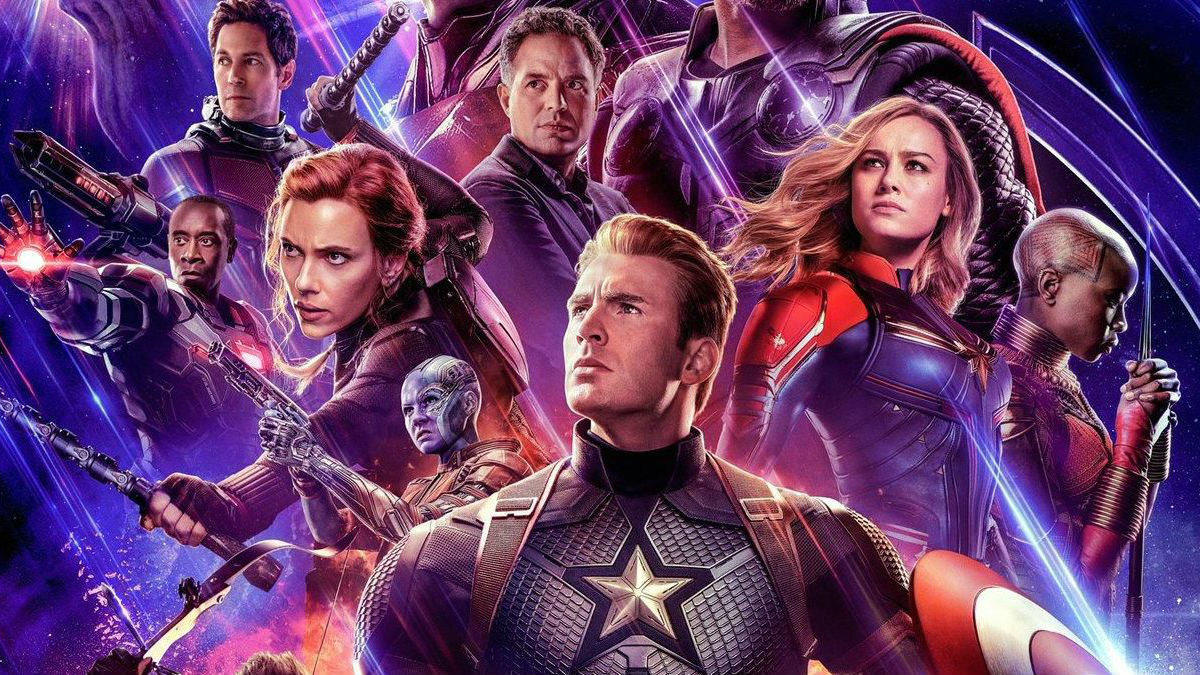
References
- “Avengers: Endgame” obliterates box office records with $1.2 billion opening
- ‘Avengers: Endgame’ Decimates Record Books with $1.2 Billion Global Debut
- All Time Box Office
- NO. 1 MOVIE WEEKEND MARKET SHARE
- “Avengers: Infinity War” Box Office
- “Avengers: Endgame” on IMDb.com
- “Avengers: Endgame” on Rottentomatoes.com
Tolkien Biopic to Be Released on May 10, 2019
The first still images from the upcoming #Tolkien biopic film have been released. They show Nicholas Hoult as the iconic #fantasy author J.R.R. Tolkien. Born 1892 in South Africa, Tolkien was orphaned as a teen after his parents died. The film (directed by Dome Karukoski) will follow these formative years as he attends school in Birmingham and finds companionship with a group of outcasts.
The still images that were released offer snapshots from J.R.R. Tolkien’s life, including his younger years with future wife Edith (being played by actress Lily Collins) and the approach of World War I. The events of that war would come to impact Tolkien’s work with #TheHobbit, #TheLordOfTheRings, and #TheSilmarillion. For example, his war experience inspired The Fellowship of the Rings, and his relationship with Edith affected how he wrote the literary romance between Aragorn and Arwen.
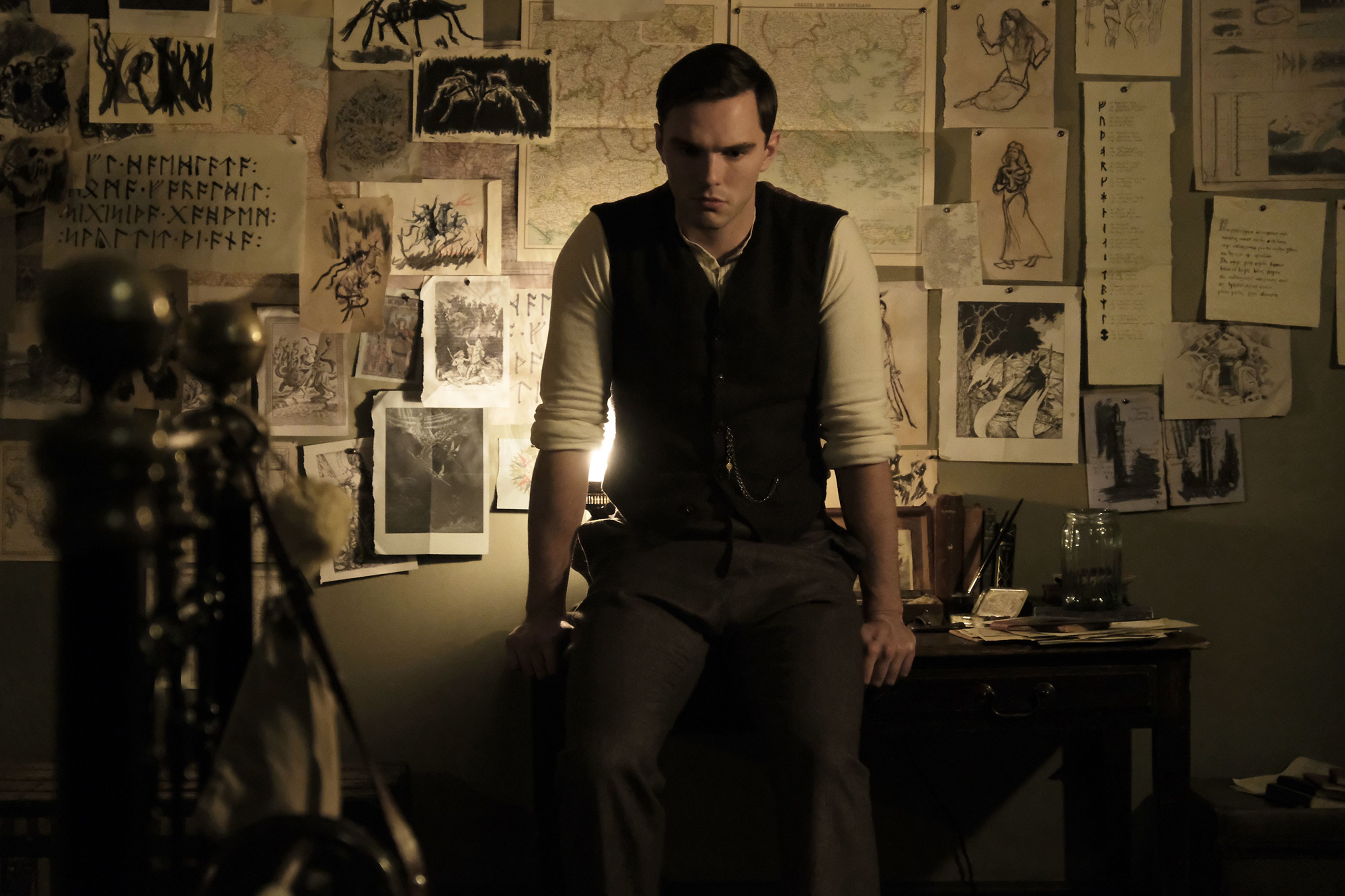
Nicholas Hoult as J.R.R. Tolkien in “Tolkien”

Nicholas Hoult as J.R.R. Tolkien & Lily Collins as Edith Bratt in “Tolkien”

Nicholas Hoult as J.R.R. Tolkien (Right) with School Chums in “Tolkien”
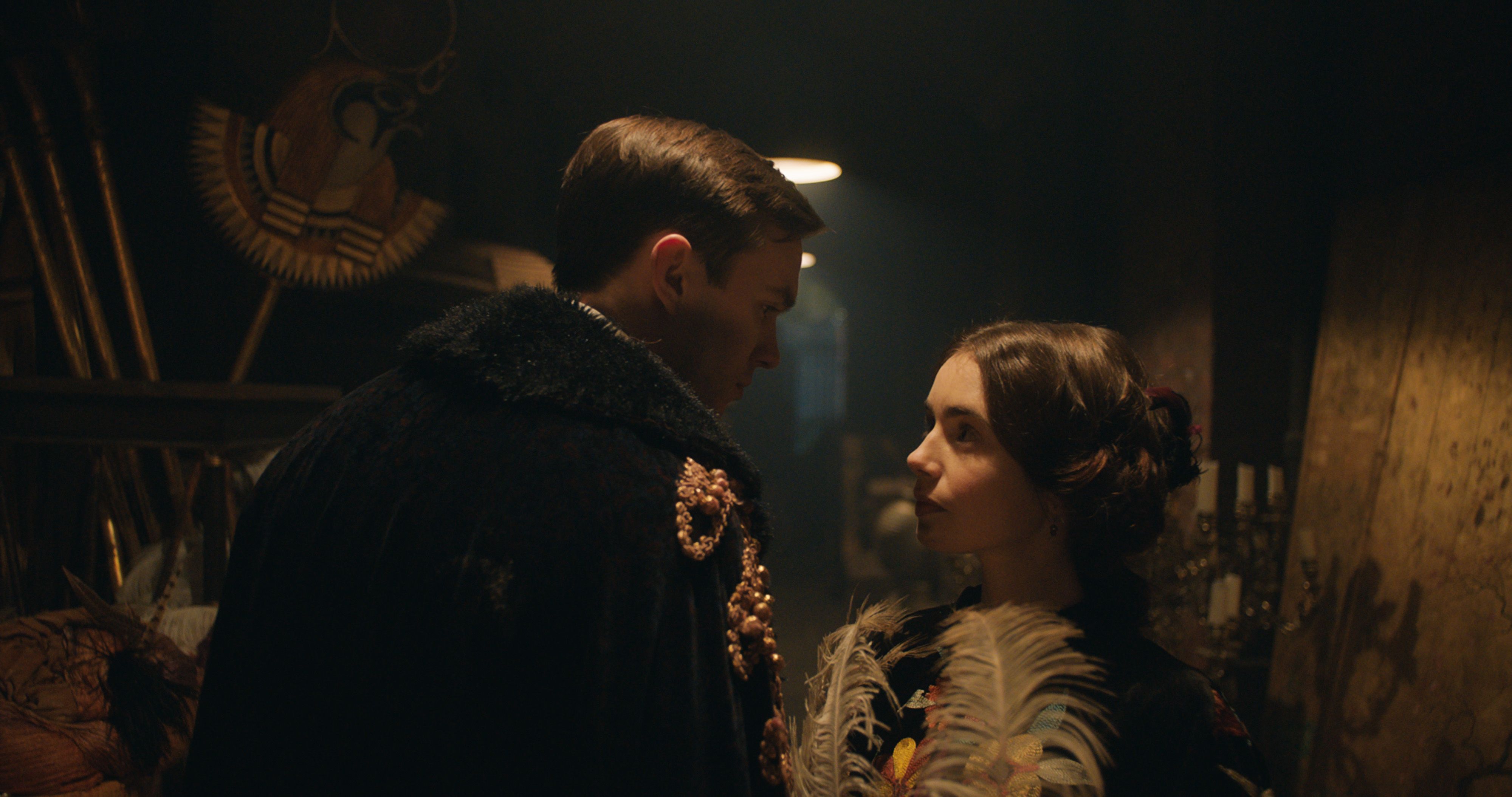
Lily Collins (as Edith Bratt) & Nicholas Hoult (as J.R.R. Tolkien) in “Tolkien”
References
91st Academy Award Nominees
The 2018 #Oscar nominees have been announced and eight #SciFi & #Fantasy films have been nominated in multiple categories, including for “Best Picture”!
The eight sci-fi & fantasy films that have received at least one nomination are as follows:
- #AvengersInfinityWar
- #BlackPanther
- #ChristopherRobin
- #IsleOfDogs
- #MaryPoppinsReturns
- #ReadyPlayerOne
- “#Solo: A #StarWars Story”
- “#SpiderMan: Into the Spider-Verse”
Award Categories Breakdown
For Best Animated Film:
- Spider-Man: Into the Spider-Verse
For Costume Design:
- Black Panther (Ruth Carter)
- Mary Poppins Returns (Sandy Powell)
For Music (Original Score):
- Black Panther (Ludwig Goransso)
- Isle of Dogs (Alexandre Desplat)
- Mary Poppins Returns (Marc Shaiman)
For Music (Original Song):
- “All the Stars” from Black Panther
- “The Place Where Lost Things Go” from Mary Poppins Returns
For Best Picture:
- Black Panther
For Production Design:
- Black Panther (Production Design: Hannah Beachler; Set Decoration: Jay Hart)
- Mary Poppins Returns (Production Design: John Myhre; Set Decoration: Gordon Sim)
For Sound Mixing:
- Black Panther (Steve Boeddeker, Brandon Proctor and Peter Devlin)
For Visual Effects:
- Avengers: Infinity War (Dan DeLeeuw, Kelly Port, Russell Earl and Dan Sudick)
- Christopher Robin (Christopher Lawrence, Michael Eames, Theo Jones and Chris Corbould)
- Ready Player One (Roger Guyett, Grady Cofer, Matthew E. Butler and David Shirk)
- Solo: A Star Wars Story (Rob Bredow, Patrick Tubach, Neal Scanlan and Dominic Tuohy)
Total Number of Nominations for Each Film
Here’s how many nominations each sci-fi & fantasy film received:
- Black Panther: 6
- Mary Poppins Returns: 4
- Avengers: Infinity War: 1
- Christopher Robin: 1
- Isle of Dogs: 1
- Ready Player One: 1
- Solo: A Star Wars Story: 1
- Spider-Man: Into the Spider-Verse: 1

References
Video Formats and Region Codes for DVD & Blu-Ray Discs
DVD and blu-ray distributors utilize two primary methods of applying digital rights management (DRM) when it comes to international distribution:
- Video formats, which vary in display resolution, aspect ratio, refresh rate, color capabilities and other qualities. Different countries use different broadcast standards that apply different video formats, which include both analog and digital formats. Analog video formats were carried over to DVD’s.
- Region codes, which is a DRM technique designed to allow rights holders to control the international distribution of a DVD & blu-ray releases, including their content, release dates, and prices, all according to the appropriate region.
Analog Video Formats Applied to DVD’s
The main types of video formats that are used in different countries based upon their broadcasting standards are as follows:
- NTSC was named after the National Television System Committee and is the analog television color system that was used in North America from 1954 until digital conversion. It was also used in most of the Americas (except Brazil, Argentina, Paraguay, Uruguay, and French Guiana), Myanmar, South Korea, Taiwan, Philippines, Japan, and some Pacific island nations and territories.
- SECAM, which stands for Séquentiel couleur à mémoire, (or “Sequential colour with memory”), is an analogue color television system first used in France beginning in 1956. It was then adopted by the former Soviet Union and used in client states and colonies.
- PAL, which stands for Phase Alternating Line, is a color encoding system for analog television that is used by broadcast television systems in most countries that broadcast at 625-line / 50 field (25 frame) per second (576i), but variants occur due to how the audio carrier frequency is handled:
- Standards B/G are used in most of Western Europe, Australia, and New Zealand
- Standard I in the UK, Ireland, Hong Kong, South Africa, and Macau
- Standards D/K (along with SECAM) in most of Central and Eastern Europe
- Standard D in mainland China. Most analogue CCTV cameras are Standard D.
- Other PAL Variants
- PAL-M in Brazil.
- PAL-N in Argentina, Paraguay and Uruguay.
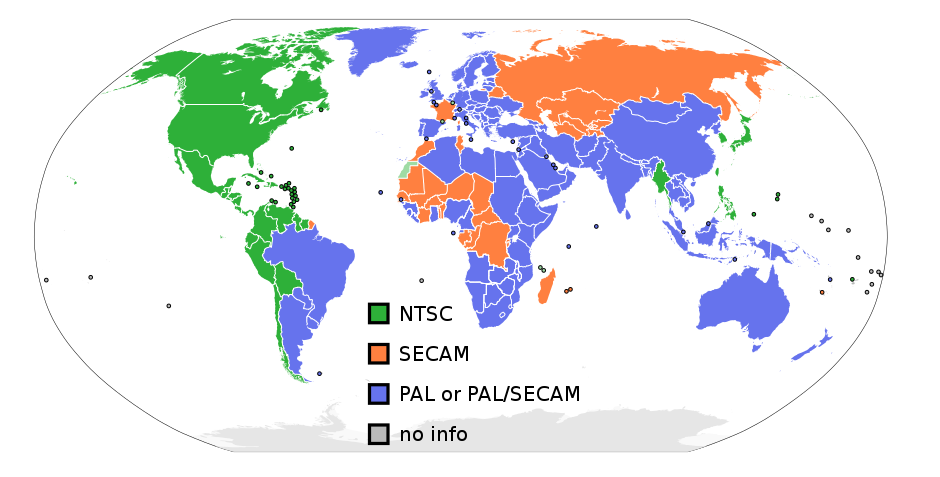
Vido Format Usage Map
Region Codes
Region codes work because the vast majority of DVD and blu-ray players sold around the world are region-locked, which means that they won’t play discs that are meant for regions outside of the intended region. Regions devised for DVD’s are not the same as regions devised for blu-rays.
DVD Region Codes
There are a total of 10 region codes for DVD’s. DVDs may use one code, a combination of codes (multi-region), every code (all region) or no codes (region free).
DVD Region codes 1 through 8 are defined as follows:
- Canada, United States, Puerto Rico.
- Europe (as of 2020 will include Belarus, Ukraine, Moldova, and the 3 Caucasus countries), Egypt, West Asia, Japan, South Africa, Greenland, and French Guiana.
- Southeast Asia, South Korea, Taiwan, Hong Kong and Macau.
- Latin America (the Americas except Canada, French Guiana, Puerto Rico and the United States) and Oceania.
- Africa (except Egypt and South Africa), Russia, Central Asia, South Asia, Mongolia, and North Korea.
- Mainland China.
- Reserved for future use, MPAA-related DVDs and “media copies” of pre-releases in Asia.
- International venues such as aircraft, cruise ships and spacecraft.
DVD Region 0 include regions 1 through 6, but do not necessarily take the video format into account. DVD Region ALL means all 1-8 flags are set, allowing the disc to be played in any location, on any player.
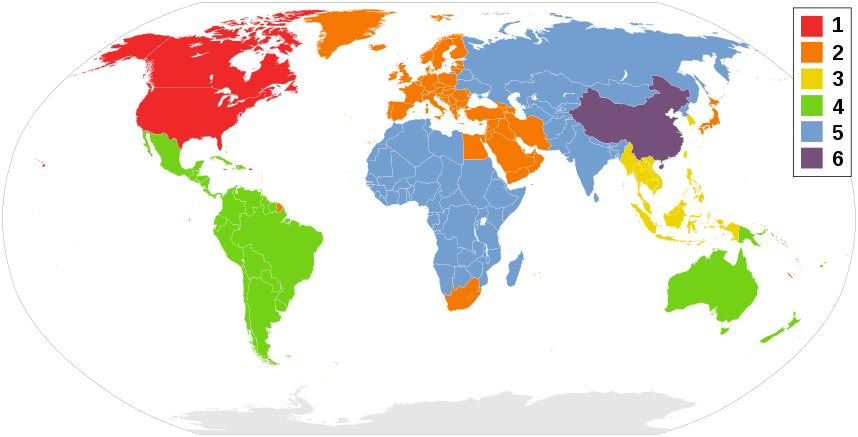
DVD Region Codes Map
Blu-ray Region Codes
Blu-ray discs use a region-code system that is much simpler than the for DVD’s as it only has three regions, labeled A, B and C. As with DVDs many Blu-rays are encoded region 0 (region free), making them suitable for players worldwide.
- Region A: The Americas and their dependencies, East Asia (except mainland China and Mongolia), and Southeast Asia; excludes instances that fall under Region C.
- Region B: Africa, Middle East, Europe (except Russia), Australia, New Zealand, and their dependencies; excludes instances that fall under Region C.
- Region C: Central Asia, mainland China, Mongolia, South Asia, Russia.
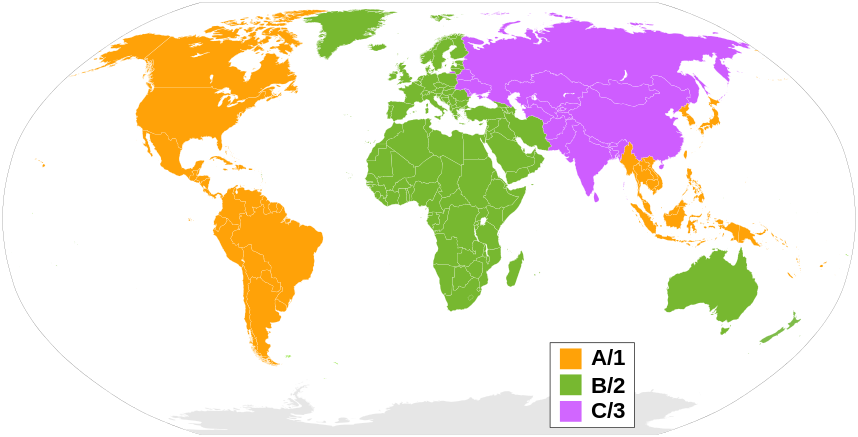
Blu-ray Region Codes Map
References
- Video Formats
- Display Resolution
- Aspect Ratio
- Refresh Rate
- NTSC
- SECAM
- PAL
- Region Codes
- Digital Rights Management (DRM)
- Region Locked
Harry Potter Movies Hitting the Big Screen Again
All 8 #HarryPotter movies and “#FantasticBeasts and #WhereToFindThem” are being re-released in September for the big screen. The 9 films will be shown from Aug. 31 through Sept. 6, 2018 at all 141 Cinemark XD locations. Festival passes that allow viewing all 9 films will be available for $25.
Cinemark XD theaters can be found in 32 states. Please note that not all Cinemark theaters are XD. We strongly recommend that you confer with a desired location to make sure that it’s an XD theater before purchasing any tickets for these showing.
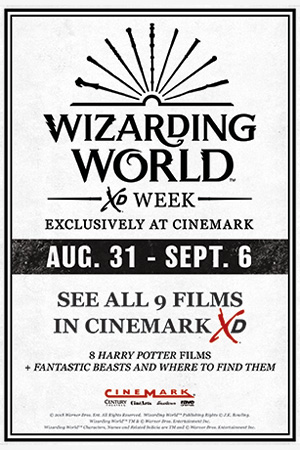
You must be logged in to post a comment.